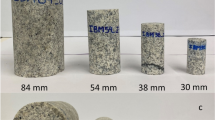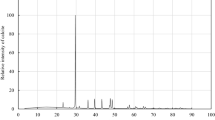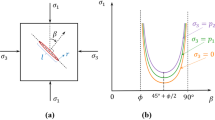Abstract
Deformation and failure of rock have size and strain rate effects. However, the coupling effect of sample size and strain rate on strength of rock is not well studied. At present, the experimental research in this area has accumulated definite experimental data, but there is a lack of theoretical model with solid theoretical basis. Therefore, in the present paper the coupling effect of sample size and strain rate on compressive strength of rock is studied theoretically. In the quasi-static loading regime, the formula for the coupling effect of sample size and strain rate on rock strength is obtained by combining the thermally activated mechanism and the static size effect law of rock strength. In the dynamic loading regime, the formula for the coupling effect of sample size and strain rate on the rock compressive strength is determined by using the Weibull’s activation law of rock defects and the shortest time condition of propagation and coalescence of cracks at different scale levels. Based on the conclusion that the strain rate sensitivity of the strength of rock is the result of competition between the coexisting thermally activated and macro-viscous mechanisms, which dominate at different ranges of strain rates, the formulae for the coupling effect of sample size and strain rate in static and dynamic regimes are superposed to obtain an unified formula for the coupling effect of strain rate and sample size effect on rock compressive strength. The critical strain rate for given sample size and the critical sample size for given strain rate are determined. The comparison with the existing theoretical models and experimental results shows that the present theoretical model is consistent with the existing theories and experimental results, indicating that the proposed model is reasonable. The present model is applicable to rocks of laboratory scale levels.
Highlights
-
The formulae for the coupling effect of sample size and strain rate on rock strength in the quasi-static and dynamic loading regimes are obtained.
-
The unified formula for the coupling effect of strain rate and sample size effect on rock strength is obtained.
-
The critical strain rate for given sample size and the critical sample size for given strain rate are determined.
-
The present model is applicable for rocks.




Similar content being viewed by others
Data availability
All data, models, or codes generated or used during the study are available from the corresponding author upon request.
Abbreviations
- \(\sigma_{1}\) :
-
Model material parameter
- Γ(*):
-
Gamma function
- V :
-
Sample volume (m3)
- V 0 :
-
Reference volume (m3)
- U 0 :
-
Activation energy (kJ/mol)
- γ :
-
Activation volume (m3)
- K :
-
Boltzmann’s constant
- T :
-
Absolute temperature (°C)
- \(\dot{\varepsilon }\) :
-
Arbitrary strain rate (s−1)
- \(\varepsilon_{0}\) :
-
The deformation limit at failure (s−1)
- \(\dot{\varepsilon }_{I}\) :
-
Intensity of the strain-rate (s−1)
- \(\dot{\varepsilon }_{cr}\) :
-
Critical strain rate (s−1)
- \(\sigma_{t}\) :
-
Uni-axial tensile stress (MPa)
- \(\sigma_{Y}\) :
-
Failure strength (MPa)
- \(\sigma_{r}\) :
-
The strength corresponding strain rate \(\dot{\varepsilon }_{r}\) (MPa)
- \(\sigma_{vis}\) :
-
Strength due to macro-viscosity (MPa)
- \(\sigma_{c}\) :
-
Static compressive strength (MPa)
- \(\sigma_{0}\) :
-
The reference stress (MPa)
- F w :
-
Opening forces of crack (N)
- r :
-
The size of cracks (mm)
- \(v_{r}\) :
-
Maximum propagation speed (mm)
- \(t\) :
-
Loading time (s)
- \(t_{r}\) :
-
The required crack propagation time (s)
- \(\Delta \sigma_{I}\) :
-
Intensity of residual stress deviator
- θ :
-
Activated crack size distribution parameter
- α 0 :
-
Material constant
- n :
-
Activated crack density
- K 1 :
-
Material constant
- \(d\) :
-
Scale level of the inhomogeneity (mm)
- \(t_{total}\) :
-
Total time required for the adjacent cracks to coalesce (s)
- \(\tau_{0}\) :
-
A temporal parameter in the order of Debye’s vibration period of atoms (s)
- \(\phi\) :
-
An angle between the initial crack surface and the load direction (º)
- \(\sigma\) :
-
Internal stress (MPa)
- \(\sigma_{r0}\) :
-
Material parameter of size effect (MPa)
- \(D_{r0}\) :
-
Material parameter of size effect (mm)
- \(l\) :
-
Distance between centers of adjacent cracks (mm)
- \(\dot{e}_{ij}\) :
-
Deviator strain-rate components (s−1)
- \(\rho\) :
-
The density of the medium (Kg/m3)
- \(v\) :
-
Relaxation velocity (mm/s)
- \(\Delta \sigma_{I}\) :
-
Intensity of residual stress deviator
- \(\mu\) :
-
Poisson’s ratio
- E :
-
Young’s elastic modulus (GPa)
- \(G\) :
-
Shear modulus (GPa)
- \(\alpha\) :
-
Strength model coefficient
- λ 0 :
-
Maximum number of cracks in unit volume
- k 0 :
-
A material constant
- \(m\) :
-
Weibull’s modulus
- D :
-
Specimen size (mm)
- S :
-
The shape parameter
- N :
-
Crack number
- k 1 :
-
A constant
- \(r_{c}\) :
-
First coalesced crack size (mm)
- \(t_{i}\) :
-
The time to crack initiation (s)
- \(t_{relax}\) :
-
Relaxation time (s)
- \(t_{M}\) :
-
Failure time (s)
- \(\eta\) :
-
Macro-viscosity (Pa·s)
- c 1 ~ c 3 :
-
Model coefficients
- d 1 ~ d 4 :
-
Material constants
- a :
-
Initial radius of disk-shaped crack(mm)
- \(n^{\prime}\) :
-
Spatial dimension of model
- \(c_{s}\) :
-
The elastic shear wave speed (m/s)
References
Ahrens T, Rubin AM (1993) Impact-induced tensional failure in rock. J Geoph Res Planets 98(E1):1185–1203. https://doi.org/10.1029/92JE02679
Asprone D, Cadoni E, Prota A et al (2009) Dynamic behavior of a Mediterranean natural stone under tensile loading. Int J Rock Mech Min Sci 46(3):514–520. https://doi.org/10.1016/j.ijrmms.2008.09.010
Atkinson BK, Meredith PG (1987) The theory of subcritical crack growth with application to minerals and rocks. In: Atkinson BK (ed) Fracture mechanics of rocks. Academic Press, London, pp 111–166
Attewell PB (1963) Dynamic fracturing of rocks, parts I, II, III. Colliery Eng 203(248–252):289–294
Bazant ZP (1984) Size effect in blunt fracture: Concrete, rock, cracks. J Eng Mech 110(4):518–535. https://doi.org/10.1061/(asce)0733-9399(1984)110:4(518)
Bazant ZP (1997) Scaling of quasi-brittle fracture: asymptotic analysis. Int J Fract 83(1):19–40. https://doi.org/10.1023/A:1007387823522
Bazant ZP, Kazemi MT (1990) Determination of fracture energy, process zone length and brittleness number from size effect, with application to rock and concrete. Int J Fract 44(1):111–131. https://doi.org/10.1007/BF00047063
Bazant ZP, Pang SD (2007) Activation energy based on extreme value statistics and size effect in brittle and quasi-brittle fracture. J Mech Phys Solids 55(1):91–134. https://doi.org/10.1016/j.jmps.2006.05.007
Bazant ZP, Planas J (1998) Fracture and size effect in concrete and other quasi-brittle materials. Routledge, New York
Bazant ZP, Xi Y (1991) Statistical size effect in quasi-brittle structure: ii. Nonlocal Theory. J Eng Mech 117(11):2623–2640. https://doi.org/10.1061/(ASCE)0733-9399(1991)117:11(2623)
Bazant ZP, Yu Q (2009) Universal size effect law and effect of crack depth on quasi-brittle structure strength. J Eng Mech 135(2):78–84. https://doi.org/10.1061/(ASCE)0733-9399(2009)135:2(78)
Bergstrom HC (1962) Energy and size distribution aspects of single particle crushing. In Proceedings of the 5th Symp on Rock Mechanics, Pergamon (pp.155-172)
Birkimer DL (1971) A possible fracture criterion for the dynamic tensile strength of rock. In Proceedings of the 12th US Symposium on Rock Mechanics, Colorado (pp.573)
Carpinteri A (1994) Scaling law and renormalization group for strength and toughness of disordered materials. Int J Solids Struct 31:291–302. https://doi.org/10.1016/0020-7683(94)90107-4
Carpinteri A, Pugno NM (2008) Mechanics of hierarchical materials. Int J Fract 150(1–2):221–226. https://doi.org/10.1007/s10704-008-9219-1
Carpinteri A, Puzzi S (2008) Self-somilarity in concrete fracture: size-scale effect and transition between different collapse mechanisms. Int J Frac 154(1–2):167–175. https://doi.org/10.1007/s10704-008-9278-3
Cherepanov GP (1979) Mechanics of brittle fracture. McGraw-Hill, New York
Cho SH, Ogata Y, Kaneko K (2003) Strain-rate dependency of the dynamic tensile strength of rock. Int J Rock Mech Min Sci 40(5):763–777. https://doi.org/10.1016/S1365-1609(03)00072-8
Comite EB (1993) CEB-FIP model code 1990: Design code. Thomas Telford Publishing
Costin KS, Grady DE (1984) Dynamic fragmentation of brittle materials using the torsional Kolsy bar. In: Proc. Conf Mech Properties at High Rate of Strain. Inst Phys Conf Ser No 70, Oxford, pp 321–328
Denoual C, Hild F (2002) Dynamic fragmentation of brittle solids: multi-scale model. Eur J Mech A/Solids 21:105–120. https://doi.org/10.1016/S0997-7538(01)01187-1
Elfahal MM, Krauthammer T (2005) Dynamic size effect in normal-and high-strength concrete cylinders. ACI Mat J 102(2):77–85. https://doi.org/10.14359/14300
Elfahal MM, Krauthammer T, Ohno T et al (2005) Size effect for normal strength concrete cylinders subjected to axial impact. Int J Impact Eng 31(4):461–481. https://doi.org/10.1016/j.ijimpeng.2004.01.003
Fairhurst C, Cook NGW (1966) The phenomenon of rock splitting parallel to the direction of maximum compression in the neighbourhood of a surface. In Proceedings of the 1st Congress on the International Society of Rock Mechanics, Lisbon (pp.687–692)
Field JE, Walley SM, Proud WG et al (2004) Review of experimental techniques for high rate deformation and shock studies. Int J Impact Eng 30(4):725–775. https://doi.org/10.1016/j.ijimpeng.2004.03.005
Germanovich LN, Carter BJ, Ingraffea AR, et al (1996). Mechanics of 3-D crack growth under compressive loads. In Proceedings of the 2nd North American Rock Mechanics Symposium, Oklahoma (pp.1151)
Grady DE (1996) Shock wave properties of brittle solids. In AIP Conference Proceedings, New York (pp.9-20)
Grady DE, Kipp ME (1979) The micromechanics of impact fracture of rock. Int J Rock Mech Min Sci Geomech Abstr 16:293–302. https://doi.org/10.1016/0148-9062(79)90240-7
Grady DE, Kipp ME (1980) Continuum modelling of explosive fracture in oil shale. Int J Rock Mech Min Sci Gemech Abstr 17:147–157. https://doi.org/10.1016/0148-9062(80)91361-3
Grady DE, Kipp ME (1985) Geometric statistics and dynamic fragmentation. J Appl Phys 58:1210–1222. https://doi.org/10.1063/1.336139
Grady DE, Lipkin J (1980) Criterion for impulsive rock rupture. Geoph Res Lett 7(4):255–258. https://doi.org/10.1029/GL007i004p00255
Holsapple KA, Schmidt RM (1987) Point source solution and coupling parameters in cratering mechanics. J Geophys Res 92(B7):6350–6376. https://doi.org/10.1029/JB092iB07p06350
Hong L, Li XB, Ma CD et al (2008) Study on size effect of rock dynamic strength and strain rate sensitivity. Chin J Rock Mech Eng 27(3):526–533. https://doi.org/10.3321/j.issn:1000-6915.2008.03.012
Housen KR, Holsapple KA (1999) Scale effects in strength-dominated collision of rocky asteroids. Icarus 142:21–33. https://doi.org/10.1006/icar.1999.6206
Hu XZ, Duan K (2008) Size effect and quasibrittle fracture: the role of FPZ. Int J Fract 154(1–2):3–14. https://doi.org/10.1007/s10704-008-9290-7
Jin L, Yu W, Du X, Yang W (2019) Mesoscopic numerical simulation of dynamic size effect on the splitting- tensile strength of concrete. Eng Fract Mech 209:317–332
Kipp ME, Grady DE, Chen EP (1980) Strain-rate dependent fracture initiation. Int J Fract 16:471–478. https://doi.org/10.1007/BF00016585
Krauthammer T, Elfahal MM, Lim J et al (2003) Size effect for high strength concrete cylinders subjected to axial impact. Int J Impact Eng 28(9):1001–1016. https://doi.org/10.1016/S0734-743X(02)00166-5
Kumar A (1968) The effect of stress rate and temperature on the strength of basalt and granite. Geophysics 33(3):501–510. https://doi.org/10.1190/1.1439947
Landau LD, Lifshitz EM (1959) Theory of elasticity. Pergamon Press, London
Lankford J (1983) The role of subcritical tensile microfracture process in compressive failure of ceramics. Fract Mech 5:45–54. https://doi.org/10.1007/978-1-4613-3488-0_37
Lei JY (2015) Comparative study on size effect of rock tensile and compressive strength under different strain rates. Dissertation for Master Degree in Geological Engineering. Nanjing University, 2015, pp 1–68
Li QM, Meng H (2003) About the dynamic strength enhancement of concrete-like materials in a split Hopkinson pressure bar test. Int J Solids Struct 40(2):343–360. https://doi.org/10.1016/S0020-7683(02)00526-7
Li F, Chen G, Long H (2020) An experimental study examining the size effect on the compressive dynamic performance of nuclear power containment concrete. Adv Mat Sci Eng 7582862:1–11. https://doi.org/10.1155/2020/7582862
Lindholm US, Yeakley LM, Nagy A (1974) The dynamic strength and fracture properties of dresser basalt. Int J Rock Mech Min Sci 11:181–191. https://doi.org/10.1016/0148-9062(74)90885-7
Meyers MA (1994) Dynamic behavior of materials. Wiley, New York
Morel S (2008) Size effect in quasibrittle fracture: derivation of the energetic size effect law from equivalent LEFM and asymptotic analysis. Int J Fract 154(1–2):15–26. https://doi.org/10.1007/s10704-008-9291-6
Perzyna P (1998) Constitutive modeling of dissipative solid for localization and fracture. In: Perzyna P (ed) Localization and fracture phenomena in inelastic solids. International Centre for Mechanical Sciences, 386. Springer, Vienna. https://doi.org/10.1007/978-3-7091-2528-1_3
Qi CZ, Wang MY, Qian QH (2009) Strain rate effects on the strength and fragmentation size of rocks. Int J Impact Eng 36(12):1355–1364. https://doi.org/10.1016/j.ijimpeng.2009.04.008
Qi CZ, Wang MY, Bai JP et al (2014) Mechanism underlying dynamic size effect on rock mass strength. Int J Impact Eng 68:1–7. https://doi.org/10.1016/j.ijimpeng.2014.01.005
Qi CZ, Wang MY, Bai JP et al (2016) Investigation into size and strain rate effects on the strength of rock-like materials. Int J Rock Mech Min Sci 86:132–140. https://doi.org/10.1016/j.ijrmms.2016.04.008
Radionov VN, Sizov IA, Tsvetkov VM (1986) Fundamental of geo-mechanics. Nedra, Moscow
Regel VR, Slutsker AE, Tomashevsky EE (1974) Kinetic nature of strength of solids. Nauka, Moscow
Rinehart JS (1965) Dynamic fracture strength of rock. In Proceedings of the 7th symp on Rock Mech, penn (pp.205-208)
Rittinger PR (1867) Lehrbuch der Aufbereitungskunde in ihrer neuesten Entwicklung und Ausbindung systematisch dargestellt. Ernst and Kern, Berlin
Rosenberg Z, Brar NS, Bless SJ (1988) Elastic precursor decay in ceramics as determined with manganin strain gauges. J Phys France Colloq 49(C3):C3-707-C3-711. https://doi.org/10.1051/JPHYSCOL:19883100
Rosin P, Rammler E (1933) The law governing the fineness of powered coal. J Inst Fuel 7:29–36
Sahouryeh E, Dyskin AV, Germanovich LN (2002) Crack growth under biaxial compression. Eng Fract Mech 69(18):2187–2198. https://doi.org/10.1016/S0013-7944(02)00015-2
Salganik RL, Rapoport L, Gotlib VA (1997) Effect of stricture on environmentally assisted subcritical crack growth in brittle materials. Int J Fract 87:21–46
Shockey DA, Curran DR, Seaman L et al (1974) Fragmentation of rock under dynamic loads. Int J Rock Mech Min Sci Geomech Abstr 11(8):303–317. https://doi.org/10.1016/0148-9062(74)91760-4
Wang XH, Zhang SR, Wang C et al (2018a) Experimental investigation of size effect of layered roller compacted concrete (RCC) under high-strain-rate loading. Constr Build Mater 165:45–57. https://doi.org/10.1016/j.conbuildmat.2018.01.033
Wang H, Dyskin A, Pasternak E et al (2018b) Effect of the intermediate principal stress on 3-D crack growth. Eng Fract Mech 204:404–420. https://doi.org/10.1016/j.engfracmech.2018.10.024
Weibull W (1951) A statistical distribution function of wide applicability. J Appl Mech 18(3):293–297. https://doi.org/10.1093/qjmam/6.4.453
Weibull W (1939a) The phenomenon of rupture in solids. In: Proc. Royal Swedish Institute of Engineering Research (Ingenioersvetenskaps Akad. Handl.) 153:1–55
Weibull W (1939b) A statistical theory of the strength of materials. Proc Royal Swedish Acad Eng Sci 151:1–45
Wu ZY, Zhang JH, Yu HF et al (2020) Coupling effect of strain rate and specimen size on the composite properties of coral aggregate concrete: a 3-D mesoscopic study. Compos B 200:108299. https://doi.org/10.1016/j.compositesb.2020.108299
Yu W, Jin L, Du X, Chen F (2022) Coupling influence of low strain rate and structural size on splitting-failure of concrete: tests and mechanism analysis. Constr Build Mater 323:126641
Zhang QB, Zhao J (2013) Determination of mechanical properties and full-field strain measurements of rock material under dynamic loads. Int J Rock Mech Min Sci 60:423–439. https://doi.org/10.1016/j.ijrmms.2013.01.005
Zhurkov SN (1965) Kinetic concept of the strength of solids. Int J Fract 1:311–323. https://doi.org/10.1007/BF03545562
Acknowledgements
The study was supported by the National Natural Science Foundation of China (NSFC grants No. 12172036, 51774018), Program for Changjiang Scholars and Innovative Research Team in University (PCSIRT, IRT_17R06).
Author information
Authors and Affiliations
Contributions
CQ: Conceptualization, Methodology, Formal analysis, Investigation, Writing—original draft, Writing—review & editing, Funding acquisition, Resources, Supervision. MW: Investigation, Writing—review & editing. Zefan Wang: Formal analysis, Investigation, Writing – review & editing. XL: Investigation, Writing—review & editing.
Corresponding author
Ethics declarations
Conflict of Interest
The authors declare that they have no known competing financial interests or personal relationships that could have appeared to influence the work reported in this paper.
Additional information
Publisher's Note
Springer Nature remains neutral with regard to jurisdictional claims in published maps and institutional affiliations.
Rights and permissions
Springer Nature or its licensor (e.g. a society or other partner) holds exclusive rights to this article under a publishing agreement with the author(s) or other rightsholder(s); author self-archiving of the accepted manuscript version of this article is solely governed by the terms of such publishing agreement and applicable law.
About this article
Cite this article
Qi, C., Wang, M., Wang, Z. et al. Study on the Coupling Effect of Sample Size and Strain Rate on Rock Compressive Strength. Rock Mech Rock Eng 56, 5103–5114 (2023). https://doi.org/10.1007/s00603-023-03309-z
Received:
Accepted:
Published:
Issue Date:
DOI: https://doi.org/10.1007/s00603-023-03309-z




